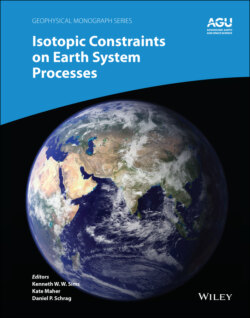Читать книгу Isotopic Constraints on Earth System Processes - Группа авторов - Страница 72
3.4. DISCUSSION 3.4.1. Calcium Isotopic Record of Marine Carbonates
ОглавлениеCalcium isotope measurements of carbonates are generally light by up to several per mil (De La Rocha & DePaolo, 2000; DePaolo, 2004; Fantle & DePaolo, 2005; Farkas et al., 2007; Griffith et al., 2008; Heuser et al., 2005; Kasemann et al., 2005; Watkins et al., 2017; Zhu & MacDougall, 1998) when compared to unmelted/non‐metasomatized peridotites (Kang et al., 2017), komatiites (Amsellem et al., 2019), and most igneous rocks (e.g., Antonelli & Simon, 2020; Chen et al. 2019; Schiller et al., 2016; Simon & DePaolo, 2010), as shown in Fig. 3.3. It is possible that the marine carbonate record may have evolved over time towards higher δ44Ca values (Farkas et al., 2007). The notion that marine carbonates had light calcium isotope in the distant past has been challenged recently by Blattler and Higgins (2017), who report that, on average, Precambrian carbonates (n=505) are indistinguishable from BSE (± 0.24‰). All carbonate sediments undergo an extended diagenetic evolution after deposition. However, the effects of recrystallization involving pore fluids on the calcium isotopic composition in modern carbonates are minor compared to the magnitude of their light calcium isotope compositions (Fantle & DePaolo, 2005; 2007). Whether Precambrian carbonates were deposited with light calcium isotope compositions and subsequently modified to heavy calcium isotope compositions remains to be seen, but some modification might be expected due to isotopic exchange with heavy seawater and/or relatively heavy Ca‐bearing fluids derived from a silicate mantle or crustal reservoir (i.e., John et al., 2012). Nevertheless, detailed work of Fantle and DePaolo (2005) and Griffith et al. (2008), followed up by the compilation of data from over 70 studies included in Fantle and Tipper (2014), shows that over at least the last ~20–30 Ma there has been a significant difference between “lighter” carbonate and “normal” silicate calcium reservoirs.
Figure 3.4 Ba/Th‐87Sr/86Sr (a), 143Nd/144Nd‐87Sr/86Sr (b), and 206Pb/204Pb‐87Sr/86Sr (c) diagrams for Central American volcanic arc lavas. All samples from the volcanic front (VF) have geochemical signatures interpreted to be elevated above values for back‐arc lavas (BA) by the addition of a sedimentary subducted component, e.g., enriched in 87Sr/86Sr. Back‐arc lavas including YO1 remain within the mantle field, reflecting mixtures of MORB‐like depleted mantle and HIMU, enriched mantle (data and illustrative mixing curves from Carr et al., 1990; Feigenson & Carr, 1986; Feigenson et al., 2004; Patino et al., 1997, 2000). Orange and gray squares represent hemipelagic and carbonate DSDP 495 sediment compositions, respectively.
